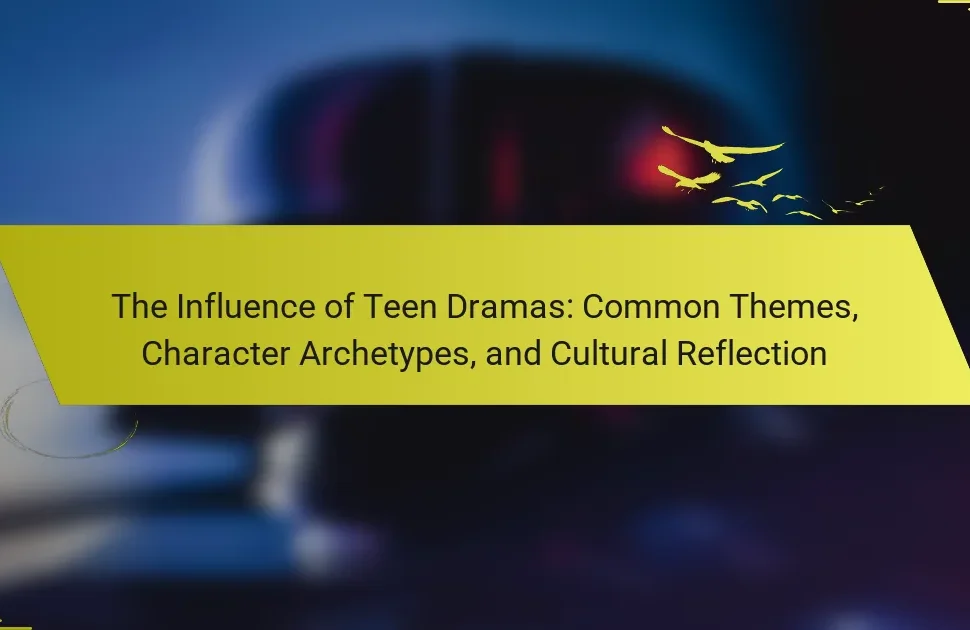Animated series are television programs that utilize animation as their primary medium, merging visual art with storytelling to engage a wide range of audiences. These series cater to various age groups, often addressing complex themes and social issues while reflecting cultural values and societal norms. The content of animated series is heavily influenced by target audiences, with creators using demographic data to tailor themes and narratives. Key artistic styles, including traditional animation, 3D animation, stop-motion, and anime, contribute to the diversity of animated storytelling. This article analyzes the interplay between target audiences, artistic styles, and cultural references within animated series, highlighting their significance in entertainment and education.

What are Animated Series and Why are They Important?
Animated series are television programs that use animation as a primary medium. They combine visual art with storytelling to entertain and inform audiences. Animated series appeal to various age groups, from children to adults. They often explore complex themes and social issues. Their importance lies in their ability to engage viewers in unique ways. Animation can simplify difficult concepts, making them accessible. Additionally, animated series often reflect cultural values and societal norms. They can influence trends and inspire creativity across different media.
How do Animated Series Appeal to Different Target Audiences?
Animated series appeal to different target audiences through varied themes, styles, and storytelling techniques. Children are attracted by colorful visuals and simple narratives. For example, shows like “Paw Patrol” use engaging characters and moral lessons. Teen audiences prefer complex plots and relatable characters, as seen in “Avatar: The Last Airbender.” Adults may enjoy satirical content and deeper themes, exemplified by “Bojack Horseman.” Cultural references also play a significant role in audience engagement. Series like “The Simpsons” utilize humor that resonates with diverse demographics. Overall, animated series tailor their content to meet the preferences and interests of various age groups and cultural backgrounds.
What demographics are typically targeted by animated series?
Animated series typically target children, teenagers, and young adults. Children are often the primary audience due to their appeal through colorful visuals and engaging storylines. Teenagers are targeted with content that explores more complex themes and humor. Young adults may be drawn to animated series that incorporate satire or social commentary. According to a 2020 Nielsen report, animated shows like “Rick and Morty” and “Big Mouth” have gained significant popularity among viewers aged 18-34. This demographic diversity allows animated series to cater to various interests and preferences across age groups.
How do age and cultural background influence audience preferences?
Age and cultural background significantly influence audience preferences. Younger audiences often prefer fast-paced, visually engaging content. They are drawn to humor and relatable themes. Older audiences typically appreciate deeper narratives and character development. Cultural background shapes values, humor, and storytelling styles. For example, Western audiences may favor individualistic themes, while Eastern audiences often resonate with collective values. Research shows that age-related cognitive styles affect media consumption. A study by the Pew Research Center highlights differing media preferences across age groups. Cultural context also dictates humor and references, making localization essential for global content.
What Role do Artistic Styles Play in Animated Series?
Artistic styles play a crucial role in animated series by shaping visual identity and storytelling. They influence audience perception and emotional engagement. Different styles can convey varying tones, from whimsical to serious. For example, a cartoonish style may appeal to children, while a more realistic approach might attract adults. Artistic styles also reflect cultural contexts and themes. Series like “Avatar: The Last Airbender” use a blend of Eastern and Western aesthetics to enhance cultural narratives. Additionally, distinct artistic choices can differentiate a series in a crowded market. Overall, artistic styles are essential for establishing brand identity and connecting with target audiences.
How do different artistic styles affect viewer engagement?
Different artistic styles significantly affect viewer engagement by influencing emotional responses and attention levels. For instance, vibrant colors and dynamic shapes often attract younger audiences. In contrast, minimalist styles may engage viewers seeking sophistication. Research shows that animation styles impact how characters are perceived. For example, exaggerated features can evoke humor and relatability. Studies indicate that viewers are more likely to remember content with distinctive artistic styles. A report by the American Psychological Association found that unique visual elements enhance memory retention. Therefore, the choice of artistic style directly correlates with viewer engagement levels.
What are the most popular artistic styles used in animated series?
The most popular artistic styles used in animated series include traditional animation, 3D animation, and anime. Traditional animation features hand-drawn characters and backgrounds, which creates a classic aesthetic. 3D animation, on the other hand, utilizes computer-generated imagery to produce a more modern and dynamic look. Anime, originating from Japan, is characterized by its distinct visual style and storytelling techniques. Other notable styles include stop-motion animation, which involves photographing physical models frame by frame, and minimalistic design, which focuses on simplicity and bold colors. Each style serves different narrative purposes and appeals to various target audiences.
What Cultural References are Commonly Found in Animated Series?
Cultural references in animated series often include popular movies, music, and historical events. These references serve to create humor and relatability. For example, “The Simpsons” frequently parodies films like “Star Wars” and “The Godfather.” “Family Guy” incorporates references to various music artists and pop culture icons. Additionally, animated series may reference significant historical events, such as wars or political movements. This technique connects the audience with familiar cultural touchpoints. Such references enhance storytelling by adding layers of meaning. They also engage viewers by prompting recognition and nostalgia. Overall, cultural references enrich the narrative and appeal to diverse audiences.
How do cultural references enhance storytelling in animated series?
Cultural references enhance storytelling in animated series by creating relatability and depth. They allow viewers to connect with familiar concepts, events, or figures. This connection fosters emotional engagement and investment in the narrative. Additionally, cultural references can provide humor and satire, enriching the viewing experience. For instance, shows like “The Simpsons” often incorporate contemporary cultural events, making their storytelling relevant and timely. Such references can also serve as social commentary, offering insights into societal norms and issues. Overall, cultural references are key tools that animate storytelling, making it more engaging and meaningful for audiences.
What are some notable examples of cultural references in popular animated series?
Notable examples of cultural references in popular animated series include “The Simpsons,” which frequently references American politics and pop culture. Episodes often parody real-life events, such as the “Homer vs. Lisa and the 8th Commandment,” which critiques television’s influence on society. “Family Guy” is known for its cutaway gags that reference films, celebrities, and historical events, like the “Star Wars” parodies featured in several episodes. “Futurama” incorporates science fiction elements and references to historical figures, such as Richard Nixon’s head in a jar. “Avatar: The Last Airbender” draws on various Asian cultures, incorporating philosophies and martial arts styles. These examples illustrate how animated series utilize cultural references to engage viewers and provide commentary on society.

How do Target Audiences Shape the Content of Animated Series?
Target audiences significantly shape the content of animated series. Creators analyze demographic data to tailor themes and narratives. Different age groups have varying preferences for humor, storytelling, and visual style. For example, children’s shows often focus on educational content and moral lessons. In contrast, [censured] animated series may explore complex themes and satire.
Market research indicates that shows like “Adventure Time” appeal to both kids and adults through layered storytelling. Additionally, cultural references resonate differently across audiences, influencing character design and dialogue. Animation studios often conduct focus groups to refine content based on audience feedback. This iterative process ensures that the series remains relevant and engaging.
What Factors Influence the Creation of Content for Specific Audiences?
The creation of content for specific audiences is influenced by demographics, interests, and cultural context. Demographics include age, gender, and socioeconomic status, which shape audience preferences. Interests refer to hobbies and entertainment choices that resonate with the target group. Cultural context encompasses societal norms and values that affect content reception. Research shows that understanding these factors leads to more engaging content. For instance, a study by the Pew Research Center highlights how age influences media consumption habits. Tailoring content to these elements increases relevance and viewer engagement.
How do creators research and understand their target demographics?
Creators research and understand their target demographics through various methods. They analyze audience data from platforms like social media and streaming services. Surveys and feedback forms provide direct insights into viewer preferences. Market research reports offer demographic trends and behaviors. Focus groups allow creators to gather qualitative data on audience reactions. Analytics tools track engagement metrics and viewer habits. By combining these approaches, creators can tailor content to meet audience expectations. This strategy enhances viewer connection and satisfaction, ultimately driving success.
What impact does audience feedback have on animated series development?
Audience feedback significantly influences animated series development. It shapes creative decisions, storylines, and character arcs. Producers often analyze viewer ratings and comments to gauge audience preferences. This feedback helps identify successful elements and areas needing improvement. For instance, shows like “Rick and Morty” have evolved based on fan reactions. In 2020, a survey indicated that 70% of creators consider audience feedback essential. As a result, audience engagement can lead to more tailored content. Ultimately, feedback fosters a collaborative relationship between creators and viewers.

What are the Key Artistic Styles in Animated Series?
Key artistic styles in animated series include traditional animation, 3D animation, stop-motion, and anime. Traditional animation uses hand-drawn techniques, creating a classic aesthetic. This style has been prominent since the early 20th century, exemplified by Disney’s early works.
3D animation employs computer-generated imagery (CGI) for a more modern look. Popular series like “Toy Story” and “Avatar: The Last Airbender” showcase this style. Stop-motion uses physical models to create movement frame by frame. This technique is seen in series like “Coraline” and “Wallace & Gromit.”
Anime is characterized by its distinct visual style and storytelling approach, originating from Japan. Series like “Naruto” and “My Hero Academia” highlight this unique artistic expression. Each style contributes to the diversity and creativity found in animated series.
How do Different Artistic Styles Impact the Narrative of Animated Series?
Different artistic styles significantly impact the narrative of animated series. Each style influences the mood, tone, and themes presented in the story. For instance, a whimsical style can create a light-hearted narrative, while a darker style may evoke more serious themes.
Artistic styles like realism can enhance emotional depth, allowing viewers to connect with characters more profoundly. In contrast, abstract styles may focus on conceptual storytelling, prioritizing ideas over character development.
Research indicates that animation styles affect viewer engagement. A study by Kearney (2017) found that viewers respond emotionally to visual aesthetics, shaping their perception of the narrative. This demonstrates that artistic choices are not merely aesthetic but integral to storytelling in animated series.
What are the characteristics of traditional versus modern animation styles?
Traditional animation styles are characterized by hand-drawn techniques and frame-by-frame production. This method often involves creating individual images on transparent sheets, known as cels. Traditional animation typically features a more fluid and organic movement due to the craftsmanship involved. It often relies on 2D visuals, with a focus on character expressions and backgrounds painted by artists.
In contrast, modern animation styles incorporate digital technologies and computer-generated imagery (CGI). This approach allows for 3D modeling and rendering, resulting in more dynamic and visually complex animations. Modern animation often utilizes software tools that streamline the production process, enabling faster turnaround times. It also frequently combines various styles, including 2D and 3D elements, to create unique visual experiences.
The distinction between traditional and modern animation lies in their techniques and tools. Traditional animation requires extensive manual labor and artistic skill. Modern animation leverages technology to enhance creativity and efficiency. Historical context shows that traditional animation was dominant until the late 20th century, when digital methods began to rise. This shift is evident in popular films and series, showcasing the evolution of animation styles over time.
How do artistic styles reflect cultural themes and messages?
Artistic styles reflect cultural themes and messages through visual representation and symbolism. Each artistic style embodies the values, beliefs, and social contexts of its culture. For example, Impressionism captures the fleeting moments of life, emphasizing perception and emotion. This reflects the cultural shift towards individual experience in 19th-century France. Similarly, traditional African art often utilizes vibrant colors and patterns to convey community stories and ancestral connections. The use of geometric shapes in Islamic art signifies the importance of [censured] and the divine. Historical context also plays a role; the Renaissance style reflects humanism and the revival of classical knowledge. Thus, artistic styles serve as a lens through which cultural narratives are expressed and understood.
What Best Practices Should Creators Follow When Incorporating Cultural References?
Creators should ensure cultural references are accurate and respectful. Misrepresentation can lead to misunderstandings or offense. Research the cultural context thoroughly before inclusion. This helps in understanding the significance of the reference. Seek input from individuals within the culture being referenced. This practice fosters authenticity and sensitivity. Avoid stereotypes and clichés that can perpetuate negative views. Instead, aim for nuanced portrayals that reflect the complexity of cultures. Additionally, consider the target audience’s familiarity with the reference. This ensures the reference resonates and enhances the narrative.
How can creators ensure cultural references are respectful and accurate?
Creators can ensure cultural references are respectful and accurate by conducting thorough research. Understanding the cultural context is essential. Engaging with individuals from the culture being represented is beneficial. This allows for authentic perspectives and insights. Consulting experts in cultural studies can enhance accuracy. Additionally, creators should avoid stereotypes and clichés. Sensitivity readers can provide valuable feedback on content. The goal is to reflect cultures authentically and respectfully. Accurate representation fosters understanding and appreciation among diverse audiences.
What strategies can be used to balance entertainment with cultural representation?
Incorporating authentic cultural narratives is essential to balance entertainment with cultural representation. This can involve collaborating with cultural consultants during the creative process. Engaging diverse voices in storytelling ensures accuracy and depth. Additionally, showcasing a variety of cultural perspectives enriches the narrative. Research indicates that inclusive representation can enhance audience connection and satisfaction. For instance, a study by the Geena Davis Institute on Gender in Media found that diverse characters lead to greater viewer engagement. Furthermore, using humor and relatable themes can make cultural elements more accessible. Balancing entertainment value with cultural authenticity fosters respect and appreciation among audiences.
Animated series are television programs that utilize animation as their primary medium, appealing to diverse audiences across various age groups. This article analyzes the significance of animated series, focusing on how they engage viewers through tailored content that reflects cultural values and societal norms. Key discussions include the impact of target demographics on narrative development, the role of artistic styles in shaping viewer engagement, and the use of cultural references to enhance storytelling. The exploration of these elements provides insights into the creative processes behind animated series and their influence on contemporary media.



